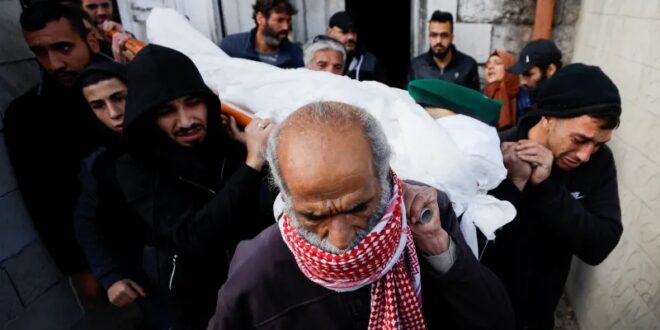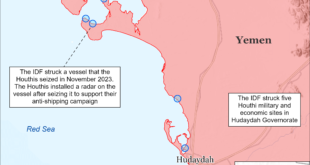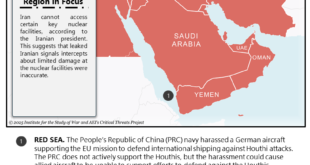Why the Israeli-Palestinian Conflict Might Boil Over Again
Since the collapse of the second intifada—a large and sustained Palestinian uprising—in 2005, the Israeli-Palestinian conflict has smoldered. Hamas has launched miniature wars in the Gaza Strip, and Palestinian armed groups and individuals have carried out terrorist attacks in the West Bank, prompting a harsh Israeli military response. Palestinians have resisted in other ways, too—marching, protesting, and throwing rocks. Despite many violent flare-ups, however, both sides have avoided fighting that reaches the scope and scale of the second intifada, even though a negotiated settlement seems more distant than ever.
But dangerous developments on both the Israeli and the Palestinian sides are now converging, and the outlook for 2023 seems grim. On January 27, terrorists attacked a synagogue in Jerusalem, killing seven people—one of the deadliest attacks on Israelis in years. It followed an Israeli raid in a refugee camp in Jenin that killed nine Palestinians, an unusually high body count.
This latest violence builds on deadly foundations. Last year was the deadliest year in Israel and the West Bank since the second intifada. Israeli forces killed 151 Palestinians in the West Bank and in Palestinian neighborhoods of East Jerusalem, almost double the figure for 2021. In Gaza, 53 Palestinians died in clashes between Israel and Palestinian Islamic Jihad, a terrorist group. Israel, too, suffered its highest death toll in years. Palestinian attacks killed 31 Israelis. The Israeli military claims that Palestinians fired on Israeli troops almost 300 times, compared with 61 in 2021 and 31 in 2020. Incidents of stone-throwing, Molotov cocktail attacks, and firebombings all rose, as well.
In November 2022, the United Nations warned that the Israeli-Palestinian conflict was “again reaching a boiling point.” Amit Saar, a top Israeli intelligence official, predicted that violence in the West Bank (although not Gaza) will rank as Israel’s second biggest challenge in 2023, just below the perennial threat from Iran. Saar warned not only that violence was increasing but also that the foundations for managing it were becoming “unstable.” The policing capacity of the Palestinian Authority, the governing body in the West Bank, and its relationship with Israel are eroding. No political process holds the promise of Palestinian independence. And ordinary Palestinians are growing frustrated with established groups and leaders that reject violence—such as Fatah, the party that has long dominated Palestinian politics, and its head, Mahmoud Abbas, the president of the PA. In yet another foreboding development, in December 2022, Prime Minister Benjamin Netanyahu created a new government that put settlers, political extremists, and racists in key positions overseeing the West Bank. All this leads to a despairing, inescapable conclusion: the odds of a third intifada are higher than they have been in years.
THE SHADOW OF THE PAST
The legacy of the second intifada still shapes politics for both Israelis and Palestinians. Between September 28, 2000, and February 8, 2005, 1,038 Israelis and 3,189 Palestinians were killed. During that time, Israeli forces demolished over 4,000 Palestinian homes and arrested thousands of Palestinians. Israel also shut down and bombed Palestinian ministries and infrastructure to coerce Palestinian leaders to end the violence.
The second intifada erupted because of a mix of factors, some particular to the time but others that could recur. Ariel Sharon, an Israeli politician who was then leader of the opposition—and, in the eyes of many Palestinians, a war criminal—triggered the uprising with a deliberately provocative visit to the site known to Jews as the Temple Mount and to Muslims as Haram al-Sharif. Palestinians rioted in response to the visit, which prompted a harsh Israeli crackdown that, in turn, killed more Palestinians, sparking more protests in a deadly cycle.
More broadly, Palestinians were frustrated with the Israeli-Palestinian peace process, which had initially raised hopes for independence but eventually stalled. The negotiations led to the creation of the PA, which was headed by longtime Palestinian leader Yasir Arafat and largely composed of officials from Fatah, the organization he co-founded. In the 1990s, the PA helped Israel crush Hamas, and both Israel and the United States looked the other way from the corruption and human rights abuses of Arafat and his cronies. Palestinians believed that Israel was dragging its feet on negotiations, refusing to make concessions, delaying transfers of territory, and wreaking havoc on the Palestinian economy through border and travel restrictions.
Hamas and factions within Fatah exploited this sentiment. As peace negotiations stalled in the 1990s, some Palestinian groups, with Arafat’s knowledge, armed for a coming conflict. When the Camp David talks failed in 2000, they seized the moment. Some hoped to use violence to force Israeli concessions. More extreme elements believed they could use terrorism to drive Israel from the West Bank and Gaza altogether. The groups often competed with one another, attacking Israel to demonstrate their resolve to ordinary Palestinians. The violence received enthusiastic support from outside Israel, with people in Saudi Arabia and other Arab and Muslim countries sending funds to Palestinians, including to the families of suicide bombers.
The last time Israelis and Palestinians had real hope for peace was the late 1990s.
As the violence grew, many Israelis came to believe the negotiations were always a sham—that Arafat was unwilling to make peace and that Palestinians were, in general, committed to violence, despite the concessions Israel offered at Camp David. Palestinians reached a similar conclusion in the opposite direction, seeing the peace process as a way for Israel to consolidate the occupation of Palestinian territories and believing that they were set up for failure at Camp David.
Arafat did not plan the violence in 2000, but he did try to exploit it, relying on his own popularity and charisma to ensure that no strong rivals among the militant leaders emerged to challenge him. He even believed he could exploit Hamas without it eclipsing his leadership. Soon, however, the violence spiraled out of his or anyone’s control. Israel’s ferocious counterterrorism response devastated Hamas and various Fatah factions, as well as the Palestinian institutional infrastructure, reducing their ability to attack Israelis. But the response also made it harder for Palestinian leaders to control the violence because the organizations had splintered.
After several bloody years, the second intifada petered out. Major armed Palestinian groups, including Hamas, declared a cease-fire in 2005, and the fighting steadily declined in the years that followed, with others, such as the al Aqsa Martyrs Brigades, eventually accepting a cease-fire, too. Negotiations did not end the violence; Israeli intelligence and military forces did. They did so by killing suspected terrorists, gathering intelligence on armed Palestinian groups, reoccupying cities in the West Bank, arresting large swaths of Palestinians, establishing checkpoints throughout the West Bank, and erecting a barrier that roughly follows the former green line between the West Bank and Israel (having already built a barrier on the Gaza border). Over time, Palestinian armed groups grew weak, and Palestinians grew weary of fighting. Arafat died in 2004, and his successor, Abbas, renounced violence.
After the 2005 cease-fire, Israeli forces withdrew from Gaza and severely restricted movement across the Gazan-Israeli border. They withdrew unilaterally, so that Abbas and the PA could not take credit by claiming to have successfully negotiated a withdrawal. Hamas was quick to declare victory, arguing credibly that its attacks, not peace talks, had led Israel to leave. Hamas won Palestinian elections in 2006 and seized power in 2007 in Gaza, cementing the division between Gaza and the West Bank and between Hamas and the Fatah leaders of the PA.
In the years that followed, Abbas and the PA often acted at the behest of Israel’s security services, helping crack down on Hamas and other violent groups in exchange for Israeli support. Israel also maintained a heavy intelligence and, at times, military presence in the West Bank. The United States, too, backed Abbas, despite the PA’s dismal human rights record and lack of legitimacy, with the latter problem becoming more acute as the PA repeatedly postponed elections. Violence in Gaza persisted. From time to time, Israel launched full-scale military operations there, often in response to Hamas rocket attacks. During these operations, Israeli forces tried to kill Palestinian leaders in Gaza, destroyed tunnels, and bombed infrastructure (sometimes deliberately and sometimes as collateral damage). Israel also maintained tight restrictions on goods going to and from Gaza, strangling its already weak economy.
VEER TO THE RIGHT
The last time Israelis and Palestinians had real hope for peace was the late 1990s. Since then, both sides have grown increasingly skeptical. Palestinians point to an intensifying occupation and ever-expanding settlements as proof that Israel has no desire to leave the West Bank. Israelis see the violence of the second intifada and Hamas’s assumption of power after the Gaza withdrawal as proof that concessions, including leaving a territory, will be rewarded with violence. Most Israelis believe that they will “always live by the sword,” in the words of a study from the Institute for National Security Studies, an Israeli think tank. The Two-State Index, a survey run by proponents of a two-state solution, found that in 2022, support for a negotiated peace had hit its lowest point since the index began in 2003. Politicians have echoed such sentiment. “This year has consolidated the fact that there is absolutely no political process,” Mustafa Barghouti, a Palestine Liberation Organization (PLO) official, lamented in 2022. Such perceptions lead to a downward spiral: as support for peace talks wanes, politicians are reluctant to endorse negotiations and instead play up communal hostility, further decreasing popular support for talks.
The current Israeli government is likely to provoke Palestinians and includes politicians who seek to expand the presence of settlers and Israel’s military in the West Bank. Although Netanyahu has served as prime minister for longer than any other Israeli, his current government differs from his old ones. In legal jeopardy because of corruption allegations, Netanyahu picked his coalition members based on who was willing to help him block the judicial process.
As a result, he has allied himself with an array of far-right figures, including open racists. Itamar Ben-Gvir—the minister for national security, a newly formed position that has authority over Israeli police—was convicted in 2007 of inciting racism and supporting a Jewish terrorist organization. Before he entered government, he hung a portrait in his living room of Baruch Goldstein, an Israeli American terrorist who gunned down 29 Palestinian worshippers in Hebron in 1994. Bezalel Smotrich, the new finance minister, led an extremist settler movement before joining the government. He will have partial control over Israel’s day-to-day operations in the West Bank, the same territory that Smotrich openly proposes annexing. Such a government may loosen restrictions on using live ammunition against protesters and rioters. It has already promised to expand settlements and some ministers have indicated they favor legalizing so-called wildcat settlements, which are built on Palestinian land without Israeli government approval and which previous Israeli governments have often shut down. Settlers, for their part, are attacking Palestinians with greater frequency while Israeli military forces stand idly by. At times, according to the UN, they have even facilitated it.
DO IT FOR THE LIKES
The previous Israeli government, headed by rotating prime ministers Naftali Bennett and Yair Lapid, was hardly gentle. But it did take small steps to improve the situation in the West Bank and Gaza, issuing a relatively high number of permits for Gazan workers and canceling a planned settlement in East Jerusalem. Yet such gestures seemed empty in the face of last year’s violence. In 2022, Israeli security forces injured more than 9,000 Palestinians, and over 30 of the 151 Palestinians killed in the West Bank were children.
New Palestinian armed groups have emerged in the West Bank, notably the Jenin Brigades in 2021 and the Lions’ Den in 2022. These groups do not fit neatly into existing categories. The Jenin Brigades receive some support from Palestinian Islamic Jihad, but young Palestinians from Hamas, Fatah, and the Popular Front for the Liberation of Palestine have also joined. The new factions enjoy significant online followings and use TikTok and other platforms to reach young Palestinians. It is particularly concerning that members of Fatah, the group intertwined with PA leadership, have joined. Indeed, some their fathers work in the PA.
Such splintering mirrors a problem Israel faced in the second intifada, when it could no longer trust its Palestinian partner because the PA would not, and at times could not, crack down on violence. If significant numbers of young Fatah members support violence today, they may sideline the peaceful faction and pressure the organization to be more militant. The Jenin Brigades and the Lions’ Den are poorly organized and lack the skill and size of Fatah during its militant days or Hamas today. But they embrace their informal structure, declaring that they are open to anyone who acts in their name—a recipe for disorganized but broad violence and lone-wolf attacks.
Dissatisfaction with the PA is widespread. Israel’s military operations and settler provocations weaken the PA’s legitimacy, showing the organization to be flimsy at best or an Israeli pawn at worst. The growth of settlements suggests that the PA is complicit in, or at least has no way to oppose, Israel’s increasing hold on the West Bank.
PARTNERS IN CRIME
The PA acts as Israel’s police force on the West Bank in part because leaders such as Abbas think that violence is counterproductive for Palestinian aspirations. But the PA also relies on funding from the EU and the United States, money it can receive only if it opposes all attacks on Israel. And such outside backing helps the PA crush more extreme political opponents who might challenge Abbas and his henchmen for power. The PA co-opts some critics and arrests, beats, and tortures others. A particularly effective PA tactic is to threaten the liberty and livelihoods of families unless they stop individual members from using violence or opposing the PA.
Yet the PA is politically weak. As Al-Haq, a Palestinian rights group, has warned, “The near-daily raids in areas under control of the PA show that the sovereignty of PA doesn’t exist.” Weapons remain plentiful, and it is easy for an angry individual to act violently. The PA also lacks democratic legitimacy. There is a good chance Abbas would lose free and fair elections if they were ever held. Indeed, in 2021, Abbas, likely fearing embarrassment at the polls, canceled long-delayed legislative elections.
A thorny succession question also looms. Abbas is 87 years old, and it is not clear who will replace him. Indeed, there are multiple succession processes: for Fatah, for the PA, and for the PLO, all of which Abbas currently heads. It’s possible that each of these organizations will take a different leader. A succession crisis is likely as factions jockey for influence.
Palestinians have little hope that the current system will bring them independence. More than two-thirds of them believe that a two-state solution is no longer viable, and many fear the new Israeli government will annex parts of the West Bank and Jerusalem. More than 70 percent of Palestinians favor the formation of armed groups such as the Lions’ Den.
DÉJÀ VU?
The situation today is dangerous, but it differs in many ways from when the second intifada broke out. Israeli security forces are more capable than they were in 2000. They have developed extensive intelligence networks throughout the West Bank and have improved their use of technology, including artificial intelligence, big data, and signals intelligence. Israel is also less reliant on its Palestinian partners for security. By 2000, Israel had allowed much of its own intelligence gathering to wither as peace talks progressed in the 1990s, and it depended heavily on cooperation with the PA. Although Israel still works closely with PA security services, it is better prepared today to act on its own.
The international picture is also worse for the Palestinians. Although polls still show broad Arab public support for the Palestinian cause, many governments are far less supportive than they were 20 years ago. In particular, Saudi Arabia, the United Arab Emirates, and other Gulf states have normalized or strengthened ties with Israel. They no longer support Palestinian violence, fearing that it will enrage their publics and thus make it hard for them to cooperate with Israel. From many erstwhile allies, Palestinians today can expect only silence.
Palestinian leaders are also wary of violence. Abbas recognizes that much of his power depends on Israeli goodwill and that factions within Fatah or its rivals want new leadership. This stands in stark contrast with Arafat, who was secure in his own popularity and believed he could control and exploit violence. Indeed, Palestinian politics and society are fragmented, and any massive mobilization, whether armed or not, will be difficult.
Even Gaza is an unexpected bright spot. Hamas remains hostile to Israel and has larger and longer-range missiles than it did in various skirmishes with Israel in the years that followed the second intifada. But its leaders seem to recognize the futility of a broader struggle and are competing for Palestinian leadership by trying to govern Gaza effectively. Israel is quick to respond to violations of the cease-fire, creating a more effective deterrent. When Israel intensely bombed Palestinian Islamic Jihad targets in Gaza in August 2022, Hamas stayed out of the fighting. In response to Hamas’s caution, Israel’s previous government permitted more Gazans to work in Israel. It also tried to ease the humanitarian crisis in the strip—for example, by allowing repairs of Gaza’s water and electricity infrastructure.
SPARKS FLYING
Predicting when violence might break out is difficult, in part because Israeli security forces also try to forecast such outbreaks and tighten security in anticipation. That said, high-profile visits to contested religious sites, such as Ben-Gvir’s visit to the Temple Mount in January, risk inciting anger.
Jerusalem, as always, remains a flash point. The new government may allow religious Jews to pray on the Temple Mount or otherwise loosen restrictions on Jewish religious activity that would violate the status quo, which endured even during the worst days of the second intifada. Such a move would suggest to Palestinians that they have lost control over Muslim holy sites. In addition, the government is likely to ramp up settlement construction in traditionally Arab areas in or near Jerusalem to permanently change the demography so that these neighborhoods are no longer primarily Palestinian, should talks about land swaps ever resume.
Meanwhile, attacks by Israeli settlers against Palestinians will likely grow. Settlers accurately believe that the government favors their presence and that the military and police will defend them, even when they initiate violence. Such government backing may inspire Palestinians to take up arms for self-defense, creating a dangerous spiral.
Politics on both sides risk exacerbating tensions. Some of Israel’s new leaders may try to exploit Palestinian violence, even in response to a provocation, to whip up Israeli support for their extreme positions. Similarly, should there be a contest to succeed Abbas, aspiring Palestinian leaders may compete to condemn Israel and call for more unrest.
It is also quite possible that violence will break out because of some small, unplanned incident: a video taken of a soldier abusing a Palestinian, a shoving match between settlers and Palestinians that escalates, or some other daily event that occurs when people live contentiously side by side. Problems may spin out of control if the PA’s security forces stop collaborating with Israel. As such, Israeli and Palestinian leaders should be prepared for violence to flare up with little notice.
WALKING ON EGGSHELLS
Israel has shown that as long as violence is not sustained and Israeli casualties remain low, it can continue its current approach. But the risk of significantly greater violence remains real, threatening not only the lives of Israelis and Palestinians but also the relations between Israel and Arab states, where peace deals are already unpopular.
To head this off, it is tempting to advise a return to negotiations that might secure a Palestinian state in exchange for security guarantees. But successful talks were a long shot a decade ago and are implausible today. The Biden administration has little appetite for a confrontation with the new Israeli government. And even if it did, the United States would probably fail to change Israeli or Palestinian politics.
The most realistic hope is simply crisis management, with the United States, Jordan, and other interested parties regularly pressing both sides not to escalate. The tentative truce with Hamas should be preserved if possible, with Israel continuing to ease conditions in Gaza if Hamas keeps its guns holstered. Israel and the United States should also engage with Palestinians outside Abbas’s coterie in preparation for his departure. Given the success of the Abraham Accords, the normalization agreements between Israel and several Arab countries, the United States should enlist Arab governments to press the PA and Hamas if violence appears to be growing.
Competition resulting from Abbas’s succession, daily low-level violence, and the creeping annexation of Palestinian areas all have the potential to escalate, and for now at least, the chance of a grand, negotiated solution has passed. Efforts from the United States and Israel’s other allies to discourage provocative visits and settlements in hot-button areas are examples of modest steps that may often fail but can head off broader confrontations. To prevent a third intifada, Israelis, Palestinians, and their partners need to think small—working every day to prevent all possible sparks from occurring and, if they do, acting quickly to prevent all the dry tinder from catching fire.
 Eurasia Press & News
Eurasia Press & News



